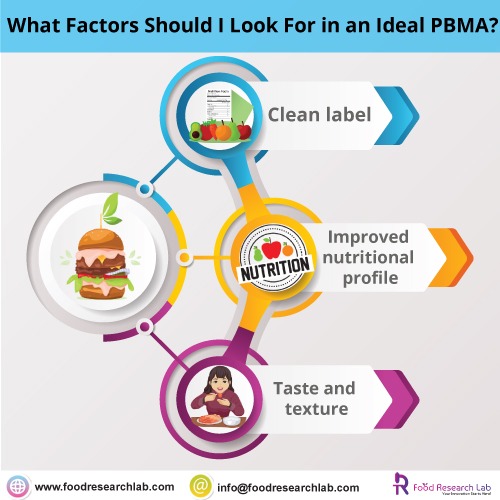Plant-based meat alternatives (PBMA) have become one of the hottest and trendiest topics in the food and research communities. This alternative market is projected to grow from US$4.6 billion in 2019 to reach $87.9 billion globally by 2032. A study conducted by Dupont suggests more than 52 % of consumers might have moved to a flexitarian diet by then(1,2). Oat based drinks and non-dairy yoghurts are not the only plant-based categories that are increasing currently; PBMA is also on the rise, as per the Forbes report. The topic of PBMA has been discussed and tested for over two decades, and a lot has changed since then. Unlike culture-based meats, food scientists and manufactures are developing new products by extracting and using more alternative proteins, which could be appropriately structured in the form of ground meat, sausages, burger patties and even seafood like foods.
To Meat or Not to Meat: Plant-based Alternatives Based on New Food Product Development
Plant-based meat alternatives (PBMA) have become one of the hottest and trendiest topics in the food and research communities. This alternative market is projected to grow from US$4.6 billion in 2019 to reach $87.9 billion globally by 2032. A study conducted by Dupont suggests more than 52 % of consumers might have moved to a flexitarian diet by then(1,2). Oat based drinks and non-dairy yoghurts are not the only plant-based categories that are increasing currently; PBMA is also on the rise, as per the Forbes report. The topic of PBMA has been discussed and tested for over two decades, and a lot has changed since then. Unlike culture-based meats, food scientists and manufactures are developing new products by extracting and using more alternative proteins, which could be appropriately structured in the form of ground meat, sausages, burger patties and even seafood like foods.
PBMA can be categorised based on the type of meat. Firstly, whole muscle meat resembles a type of muscle cut, for instance, steak, chicken/turkey breast etc. Companies such as NovaMeatTM is developing a version of steak meat made from pea and rice protein. The scientific research community is also focusing on a 2-D printed structure that will give the product a realistic texture and mouthfeel to the customers. Secondly, restructured meat is made to substitute minced meat products, such as ground beef, meatballs, nuggets and sausages. Companies such as Beyond BurgerTM, The Meatless Farm coTM and Impossible BurgerTM manufacture products under this category (3). Food Research Lab from India is also now part of this product development category.
How are PBMAs made?
Plant-based meats are made from a heterogeneous mix of ingredients based on the type of meat made. For instance, grain and legumes are either milled into flours or concentrated on making isolates, which make up for proteins. Ingredients are put through hydration, shearing and cooking, before extrusion to mimic meat-like characteristics (4). Unwanted aromas, flavours, or textures are removed to make the perfect plant-based steak or burger patties. Fiber and starch components are also extracted from grains and legumes to achieve a realistic fibrous composition in a slice of whole muscle meat and also in sausage casings. Another methodology to create realism in PBMA is fermentation. Plant-based heme molecule allows (soy leghemoglobin) burgers to bleed just like a normal burger would. A company named Impossible FoodTM created this heme molecule by engineering yeast to produce heme upon fermentation.
New Product Innovation to deliver tastier and healthier products.
Consumers desire for plant-based products aren’t from a specific segment of the population who are vegetarians or vegan alone. Rather, flexitarians are largely driving the new creative plant-based products to market. Meat alternatives have a better mouthfeel, better taste and aroma, with closer to meat colour before and after cooking. Due to the combination of high-quality protein derived from plants, the final output will much tastier than products from two decades ago (5). Therefore, NPD innovation deserves credit for the rising plant-based trend.
Impact on the environment
In recent times, people are following “Meatless Mondays”, a flexitarian concept to encourage people to make the shift. Consumer’s concerns are driving purchase decisions, although most consumers aren’t giving up meat entirely. The main concern with adopting a flexitarian diet is convenience. Consumers mainly focus on accessibility and affordability. As many manufacturers are adapting to PBMAs, consumers can expect to change up their diet, even if it is just for one day (6, 7).
PBMAs are less damaging to the climate and environment and vastly more sustainable, as it produces 90 % fewer greenhouse gas emissions compared to conventional meat. Animal breeding and agriculture use 70 % of the total available land on the planet while producing 20% of the outcome to the food supply chain. Overall water consumption is decreased, as one pound of meat requires 6400 litres of water, whereas one pound of vegetables take 150 litres of water. Moreover, many types of pollution (such as water and nutrient) associated with meat production are completely avoided by PBMAs.
Prying into future
PBMAs represent the right kind of change that the world needs during a time of climate catastrophe, as many people are suffering from many negative health impacts. Plant-based protein products such as tofu, tempeh, seitan have been documented since ancient times. Later, texture vegetable protein (TVP) was invented, and this was further advanced to use as the main ingredient for vegan versions of meat-based diseases such as bacons and burgers. Chickpeas and soybeans are ideal for PBMA production whereas proteins from insects and zein are the cost effective. Oil seeds also provide adequate amino acids when paired with dry foods such as cereals. Microalgae spirulina can be suitable meat alternative, (30-50% spirulina to soy protein), mushroom, peanut protein biomass waste, and edible insects based meat alternatives, has begun as an acceptance by a number of consumers.
But how healthier are the plant-based options. Is the product “free from,” claiming the clean label, and contains a high nutritional value or perhaps everything? PBMAs may not always be nutritionally equivalent (8). Plant-based options try to balance off the calorie content to match meat products; however, they might vary in micronutrients, such as sodium, iron etc. Plant-based burger patties contain 250 calories, whereas ground beef amounts to 290 calories. However, the downside is meat contains 5 times more sodium compared to the plant-based option. Plant-based dairy alternatives contain much fewer protein and calcium compared to dairy products. Another major drawback with PBMAs is they are processed heavily and loaded with artificial ingredients, often listing more than 15 to 20 ingredients. Some products may also not be GMO-free. This raises warning flags to customers as most desire a simple way of eating.
What factors should I look for in an ideal PBMA?
- Clean label: Add real ingredients, such as vegetables, to your diet if you are planning to cut down on meat.
- Improved nutritional profile: Look for options with an ideal amount of sodium, higher protein content and better-quality options, similar to the real meat products.
- Taste and texture: Food manufacturers are trying hard to achieve the meat-like taste and texture of their products. So do not compromise on quality; try different brands until you get impressed.

In conclusion, the PBMAs are an opportunity; however, the perfect meat alternatives is still a work in progress. So, next time when you are at the grocery store shelves, try plant-based meat or when you are at a fast-food restaurant, try a meatless burger out of curiosity.
We have the experience, knowledge and ingredients portfolio to help you develop
Interested in learn more? Get in touch, we’d love to discuss your next project with you
About Food Research Lab
With many years of passion and experience in the food and beverage development industry, Food Research Lab serves as a one-stop solution for all your food business needs, from designing your new product such as plant-based meat alternatives, shelf life analyses, or testing or to enhance an existing one. Our team comprised of food technologists, nutritionists, chemists, microbiologists, flavour experts, culinary experts and many more. Our food technology experts will help you through a plethora of rules and regulations across the globe to enable your product (food & nutraceuticals/supplements) to reach customers hands promptly. By working directly with us, you’re assured of getting a dynamic, innovative product of your specifications. We will also help you with a cost analysis of a new food product development for the specification and certification process of your product. Reach us at [email protected]
Dr Raj (PhD), Food Scientist with 10 Years of Working Experience in Various FMCGs & Currently consultant at Food Research Lab

Let’s create something Innovative and Delicious together
Food Research Lab strives for excellence in new Food, Beverage and Nutraceutical Product Research and Development by offering cutting edge scientific analysis and expertise.




